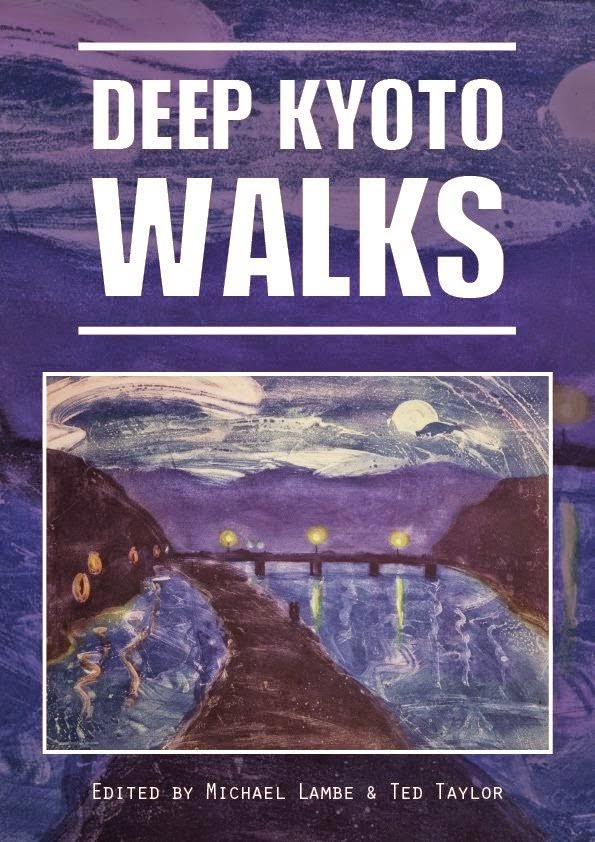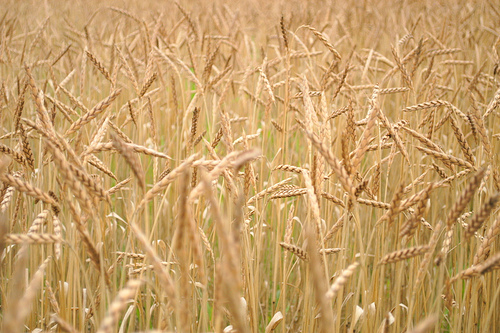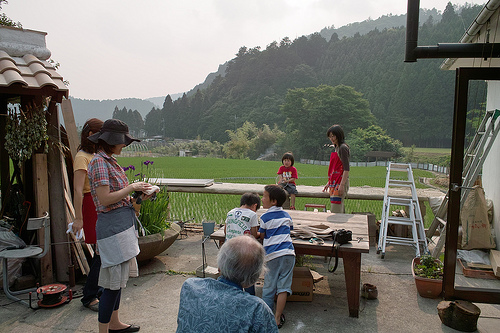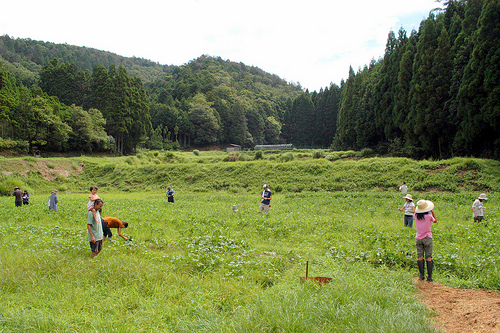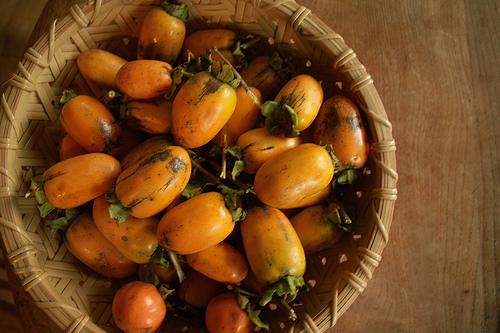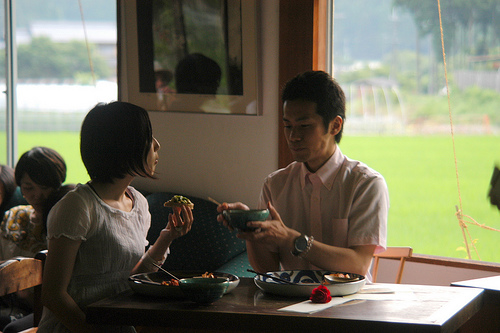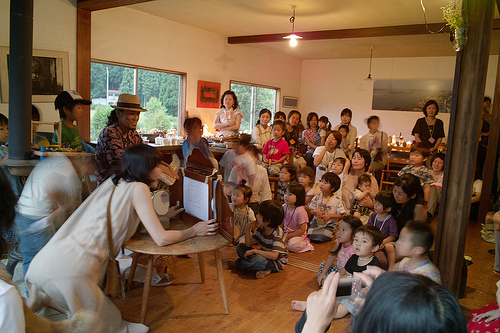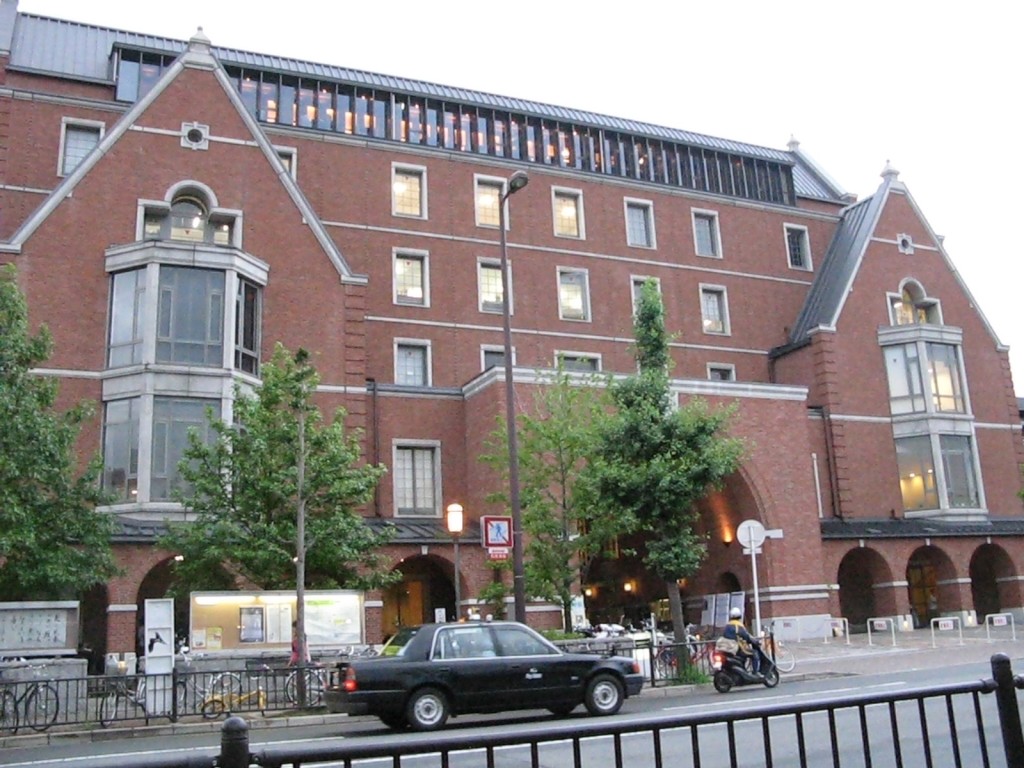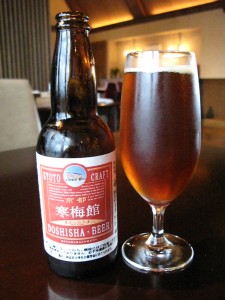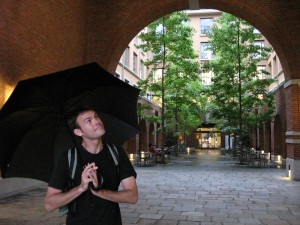Thursday, December 03, 2009
So Much Water So Close To Home
My last day in Yonago, I went to see a Doctor of Chinese Medicine about my knee. He told me that my body has too much liquid, and gave me some herbs to remedy that. But how can I escape all this water?
It is beside my train, in the form of a river along which a tug pulls a barge loaded with dirt from what was once a mountain. This train stops at Kinosaki, its passengers disembarking for a three day weekend soaking in hot baths. My next train follows the Sea of Japan, whose rocky shoreline is carved by more water, both serving as natural defenses against ancient enemies.
In Yonago, I spend a few days feeding on crab and other things that this water offers, as if trying to instantaneously recoup the 7 kilograms lost during a 10 week walk.
Another train struts along other water, trapped in rice paddies now plowed into hourglass shapes. At Gotsu I follow the Ko no Kawa south to spend a couple days with Jake. On one of these we watch the water leap and rush through the narrow Senjokei. A month ago, Kagura performers mimicked this movement as they danced in the surrounding shrines now quiet on this warm autumn afternoon.
Thumb south to Tomo no Ura and Sensuijima floating in the Seto-Naikai. I hike around what the locals call `kemono no michi,` or trail of beasts. Where there are views, I sit and squint at the words on a page in the glare of sunlight reflecting brightly on water. I`ve always had a great attraction to these waters, love to walk the desert-like hills high over the waves. I often escaped down here with friends long returned to their homes, far away where water merges with other water. And I too will be soon gone, and the sentimentality I feel is a weight heavy, like the Bizen cup from which I drink my beer. I toast these ghosts, and then again. There is always the feeling of aware in off-season beach towns, yet mine is compounded and I often feel near tears. Leaving this country is like a breakup with someone I`m still deeply in love with.
There is other water too: at the end of the narrow alleys of Tomo no Ura; along the waterfront of Onomichi, above which I wander the hills between old temples; forming the spread fingers of the Hiroshima delta; at the southern edge of an overly built-up town facing Miyajima, where I spend my final days.
And the sentimentality lasts, though it could be that I have far too many minor chords on my iPod, making up the nostalgic songs that themselves flowed through all the different lives I`ve lived here. As an English teacher well-enthused at an expat life. As the husband and father. As a hollow shadow, trying to pull myself from the wreckage of a life destroyed. As a person in reconstruction, rebuilding myself in a new city.
Escape from the water. Tough to do on an island. Today I will cross over it, to see where the flow goes once beyond its limits...
On the turntable: Beatles, "Rubber Soul"
On the nighttable: Robert Stone, "Damascus Gate"
Tuesday, November 17, 2009
Feet Up
Wednesday, October 14, 2009
Friday, September 11, 2009
Cafe Millet
http://www.deepkyoto.com/cafe-millet/
"Ted Taylor writes…
On a warm autumn afternoon, during a north Kyoto hike from Ohara over
to Kurama, we came across a group of young people building a wood
burning oven out of stone. Standing in front of this ishigama, we made
small talk with the young couple in charge of the project. The young
woman told us that the bread that this oven would bake would be a
centerpiece of the cafe that had just opened here, her hand gesturing at
a comfortable looking building made of wood and glass. We promised to
come back again.
A month or so later we ran into them again in Ohara, this time as part of a larger group busy harvesting adzuki and soy, some of which would wind up that night on the table of Cafe Millet.
What at first seems like a throwback scene to the old hippie days is
actually a large and growing trend in Japan. Driven by both
environmental and economic concerns, many young Japanese are shunning a
life in the cities for one in the soil.
The idea of returning to the countryside is hardly a new one. Masanobu Fukuoka’s classic work, “The One-Straw Revolution” has for over 30 years lured people back to a traditional life of farming. What is different this time is that the movement is not simply at the personal or grass roots level. In March of this year, Prime Minister Taro Aso created the Rural Labor Squad, as a way to give employment to the young while simultaneously revitalizing rural communities and their dwindling labor pool. Local farmers are for the most part grateful for the help, though some feel that the young will once again return to the city when the economy picks up.
While some people are able to make this I-turn to the countryside, others are taking on the more modest task of planting crops atop buildings in some of Japan’s urban centers. The focus here is more environmental, with growing concerns about food safety after a recent chain of tainted food scandals. This movement too is encouraged by the municipal governments, as a means in which to lower the summer heat index, as temperatures soar due to an overabundance of heat-absorbing concrete and asphalt. This heat in turn increases air-conditioner use, leading to higher carbon emissions. As a previous generation had found inspiration in Fukuoka’s book, these current farmers (both in the city and the country) have found a spokesman in Naoki Shiomi, with his series of books espousing a practical life style of “Half-Farmer and Half-X.”
For Juri Sumioka, Cafe Millet’s owner, the transition was no real transition at all. “When I was a kid, I used to enjoy making things with my friends. Since high school, I’ve had more opportunity to cook for people. It was only natural that I’d open a cafe.” Her husband Atsushi agrees that it had come naturally. “I one day noticed that I’d already been living this way. I was into growing food long before I was into cooking. Growing rice led me to an interest in growing wheat. That led of course to my bread making.”
The organic food movement in Japan is by no means new. The current interest originated a decade ago with middle aged women who, watching many men of their generation succumb to cancer and heart disease, began to take a greater interest in the source of their food. What makes Cafe Millet special is that everything served is grown in the surrounding fields and gardens. This has greater benefits than simple delicious ingredients. “I feel great happiness in reaping the blessings of a life lived naturally, and not being occupied with doing business but instead, simply living. Around food we can create a community out of all sorts of people, of any age or occupation,” Juri says. “With money, we can quickly accomplish just about anything. But I find much more value in time spent in the present, with family and neighbors. Plus being able to live according to the rhythms of nature, amidst food growing all around you, it is easy to pass the time in an valuable way.”
On her philosophy of cooking: “We hope that people who come to eat here feel that our food is similar to their own mother’s cooking, and find that ‘The heart of all is connected by food,’ which is our motto, of sorts” She adds, “People also can feel that we put our hearts into producing the ingredients. Even with so called high cuisine that uses very expensive ingredients, if it was prepared without love and care, it doesn’t resonate in the soul. Eating is a natural act for animals and people, but I think that it has a very important role in the formation of our body and spirit.”
Working together as a couple has many benefits. While Juri is responsible for what appears on the table, Atsushi provides the materials. “How vegetables are grown is important, of course, but the fact that they are organic vegetables made without pesticides is not the only important information. We also need to consider the manner in which they are sold, the environment where the vegetables grow, the methods of the farmers. We must ask questions like, ‘What nutrients are there?’ ‘What is most effective?’ ‘Where was it produced?’ ‘At what cost?’ And for us, the most important question is, “Does the food have soul?”
His own approach to agriculture borders on the spiritual. “Vegetables and grains have a characteristic flavour and shape. Yet beyond the shape, we ask ‘Is there ki?’, ‘Is there consciousness?’ You can easily see this from the state of the produce. There are veggies that are entirely eaten by insects, and some that aren’t at all. If you take a look, you can see that those not eaten by bugs are vibrant and brimming with vitality. Those that are partially eaten are limp and weak. It’s the same as how when our immunity and energy are weak, we slip into disease. All produce is made from sun, water, earth, and human labor. It reflects the environment in which it was made. Science can give insight into proteins, carbohydrates and the composition of food, but the form a vegetable takes is determined only by its molecular structure. Vegetables are nourished by sun, energized by the power of innumerable microorganisms, and take form by the farmer’s labour. Eating the vegetable makes us one with the place.”
The quality of food served isn’t the only thing soulful about a meal at Cafe Millet. You dine in an airy room full of natural light, surrounded by photographs and implements of a country lifestyle, many no longer used and relegated to the status of ‘antique.’ The kitchen, visible from the table, is spacious and open, all stone and wood like the kitchens of southern Europe. There is a great sense of peace in the cafe’s location too. It is located at the head of the Shizuhara valley, with views across rice paddies stretching away to the mountains that mark the border of Kurama. “When we have our meals, we can feel the wind come down from the mountains and across the fields, and see the next generation of ingredients from the window. This helps us to enjoy the food more. It is part of the food’s essence,” Juri explains.
The cafe also has regular events, mostly based around the theme, “Agriculture and Food.” These events usually take shape as vegetarian cooking classes, yoga workshops, and live music sessions, events that are always stimulating and inspiring.
“Shizuhara is located between the sightseeing centers of Ohara and Kurama, but actually there is very little to see here, tourist-wise. Seemingly there is nothing, but there is quiet, and the slow passing of time. We try to plan events and projects by thinking about making the best use of this environment as we can.” Atsushi adds, “We think it is important to experience things for yourself. By hosting workshops, we can continue to pursue things we enjoy. I think that if we actively pursue those things that greatly interest us, we can easily have the type of life that we desire.’
He feels that this is one of the catalysts for the recent migration of young people. “Many people these days don’t have any drive or ambition, and are lost as how to live. But by simply living in the present, in following their bliss, they’ll eventually find their own way to live.” Juri too feels it important to continue chasing what you like. “You’ll meet people and have experiences that you’d never expected.”
Atsushi feels that “there is growing doubt in the lifestyle of cities, living in apartment houses where you can’t see the ground, doubt in the ideas of our parents’ generation with its mass production and mindless consumption. They are beginning to seek life in a natural, rich environment. These young people are attracted to the idea of working with the soil in heavy labor. The number who relocate to the countryside and assume organic farming as work has increased every year.” Juri adds, “I truly believe we are in an age of change, and more and more people will actively seek a new lifestyle.”
And on their own changes, what are their more long-term plans for Cafe Millet?
“We are in the process of building a tree house in the big zelkova tree
down by the stream. Later, we hope to keep a donkey nearby. In the old
days of Kyoto, people used to sell bread from donkey-drawn carts that
would circle throughout the city. We are toying with the idea of
starting that up again. In addition, many people are beginning to
bring their kids to Millet, and it is becoming something of a natural
daycare center. I want it to be a place where kids can come learn and
play. An environment where people can raise food and be around animals.
And meet the local people, who also can benefit from this exchange.”
Juri says, “Most of our inspiration comes from people, from friends and the older farmers in this village. The traditions of this region shaped its vegetables and in eating them it makes us part of this place. Since we can never predict the ways of nature, we never know how a harvest will turn out. There is always great excitement at seeing the bounty we get.”
A sample of this bounty is available by reservation only. Call 075-741-3303
For directions and workshop information check their website (Japanese only). Here is a map.
Text by Ted Taylor.
Pictures courtesy of Cafe Millet."
On the turntable: U2, "Songs of Innocence"
Friday, September 04, 2009
Ted Talks
http://www.deepkyoto.com/ted-talks/
"When you describe Kyoto, you couldn’t
skip them; pure water, old wooden house in a row, and food culture.
This is beer whose mother is the honorable tradition in Kyoto, and whose
father is beer boasted of by Germany. A new historical chapter is
recorded in our culture.
From the KANBAIKAN craft beer label.
A few months ago there was a big conference in England where all kinds of impressive people got together, and talked about impressive and inspiring things. If you go to the website TED TALKS you can take a look at some videos from the conference. They really are very impressive, but oddly there doesn’t seem to be anyone there whose name is actually Ted. Here on Deep Kyoto we can go one better, with our very own (and impressive) Ted Taylor. As I knew he was leaving at the end of summer (today actually), I decided to interview him before he left. So, one afternoon in July we took the JR line from Karasuma/Shijo up to Imadegawa, got out at exit 2 and there we were at Doshisha University’s Kanbaikan building.
We’d been talking about coming here for some time because on the 7th floor of the Kanbaikan, there is a French restaurant called Second House Will that serves Doshisha’s very own craft beer; also called Kanbaikan. The Kanbaikan (寒梅館 which means Cold Plum Inn I guess) is an impressive red brick building with gorgeous views over the city and we enjoyed its namesake beer, also reddish brown in color, along with some crunchy French bread and a plate of tasty hors d’oeuvres. It was a very pleasant way to spend a summer afternoon and you can find a map here if you want to try it for yourself. However, as I knew Ted was leaving at the end of summer, I figured this was a good opportunity to chat with him about not just beer, but about zen, and hiking and writing and about his life in Japan and so on. You know; all things Ted.
Ted: I don’t know if you’ve read Alan Booth’s Roads to Sata
but I was reading his books again. It’s funny when I read it two or
three months after coming to Japan, I read it and I thought this guy is
just a grumpy old dude who is just an alcoholic. But now I read it with
hindsight and I’m like: this guy has Japan nailed. [laughs] At
the time, you know, you’re new here and you don’t want to look at the
bad stuff. But he nails it. He gets right to the heart of what’s wrong,
or not what’s wrong, but what is somewhat… annoying.
Michael: Irksome.
T: Yeah, irksome. But I read it now and I was so
inspired, because I’ve been saying for a decade “I don’t drink yellow
beer. I don’t drink yellow beer.” I like heavier beers. I like more of a
rich taste. I like malts…The best time, the only time I would choose to
drink yellow beer is for sushi because for some reason the temperature
of beer in sushi shops is absolutely perfect. It’s like the right amount
of cold. From an American point of view. I know you guys drink it
warmer but… But I always prefer these kind of things. [taps his glass]
M: Yeah… but I like a nama, a cold nama.
T: But this is the thing. Reading Roads to Sata;
every day he’s walking and every night he’s drinking somewhere local
with the local folk. And this is 1976, so foreigners in the middle of
nowhere were really rare, but it got me switching back to Japanese beers
again. Now I love to have… like tonight when I go home, I’ll have Asahi with dinner. And it’s great because it’s so light and it’s summer.
M: Yeah… I suppose I should interview you now.
T: OK. If you’ve got any good questions I’d be happy to answer them or avoid them.
M: What do you think of this beer?
T: I’m kind of happy with it. It’s got a nice color to
it… It is the perfect example of a Japanese attempt to make a dark beer;
where it’s dark in color but not in taste. But it’s still very
palatable. It washes down the crab quite nicely I must say.
M: Now summarize your life in ten easy words.
T: Summarize my life?
M: In ten easy words!
T: I don’t know. “Follow your bliss” man. I mean, I’m stealing that from Joseph Campbell. “Follow your bliss” is an academic way of saying follow the path of least resistance…
M: What brought you to Japan in the first place?
T: I wanted to do zen and aikido.
M: Had you been doing that before?
T: Yeah. And the beautiful irony of the whole story is that all those years I lived in Tottori,
I was doing zazen, going to the temple twice a week for years, coming
to Kyoto every other month, sitting, going for a few days in a temple…
I’ve been in Kyoto for almost three years now. I’ve been to zen sittings
maybe three times in three years. I think that’s completely crazy.
M: Why did that happen?
T: It’s my sort of protest in a way. All those years I
was coming down to do meditation here I could sit anywhere for free and
suddenly in the last three or four years when you want to sit somewhere:
500 yen, a 1000 yen. I feel like it’s become a touristy thing, it’s
become a museum piece, there’s no reality, although I could introduce
you to someone that’s on Horikawa that’s amazing. Basically every day
there’s a zazen session. No money. Totally pure.
M: Where is that?
T: It’s on Horikawa, one or two lights below
Kuramaguchi. A little bit hidden behind trees but there is a temple
there. And I went and sat there once and he’s amazing, because he’s
super nice and super friendly but when you’re actually in the
meditation, he’s quite strict…
M: Does he whack you with a stick?
T: Well, if you want him to. It depends on your proclivities.
M: Yeah, I said “easy words”! Never mind your proclivities!
T: When I lived on the west side. I lived literally next door to Kinkakuji and then just up the road at Daitokuji there was a temple that I’d been interested in for years because Gary Snyder who was a catalyst for me coming to Japan, he trained there and lived there for a long time.
M: Who’s Gary Snyder?
T: He’s a famous poet from sort of the beat period so
like the 50’s into the 60’s. But he lived in Kyoto, if I’m not mistaken,
I think he was here 9 years…?
M: And he was one of your formative influences in getting into zen?
T: Yeah, I think it was reading about him and getting
to know a little bit more about his life that got me interested in
coming to Japan.
M: But how long were you in Tottori?
T: 12 years.
M: 12 years in Tottori. You liked it?
T: Tottori? Yeah. Tottori was a good time. I mean I’m
not a city person, so as much as I love Kyoto for many reasons, when I
go back to Tottori I realize that what I had there was really special
and unique. I mean you were one of twenty foreigners there and I was one
of the few people in town, (and this isn’t pride in saying this it’s a
lot more longevity than my own effort), but I spoke Japanese pretty well
up there, so I was able to open a lot of doors and do a lot of things
up there that I obviously could not have if I hadn’t spoken Japanese.
And you know the fact that I could bike to the beach in ten minutes, and
I could drive up to the ski slopes in twenty minutes. It was a good
place to be. But the thing is ironically the whole time I was up there I
was longing to be in Kyoto and I was coming down here every couple of
months!
M: What finally made you move?
T: I got a chance to study a quite rare style of
jujitsu that’s based here. My teacher is up on a mountain north of
Kyoto. And I was invited to start training and so for a year I commuted
once a week down to Kyoto to train and then it was just a place I wanted
to be. I felt I graduated from inaka. I felt I graduated and it was
time to go up to the city.
M: When you were in Tottori you were teaching English originally?
T: For a while, I’d say the first eight years or so I
did that and then I started doing more translation work but there wasn’t
a lot of work up there and that’s when I started doing yoga.
M: How did you study that in Tottori?
T: There was one teacher I found later around ’98 but
originally I started about ’95. In the States, there’s an incredible
amount of stretching before practice in martial arts study and I was
doing martial arts then and you know teachers don’t want to get sued if
someone gets hurt. You know the liability culture that we have. But when
I was in Japan, there was almost no stretching at all. So I wanted to
take better care of myself and a friend of mine, he introduced me to a
book; a yoga book. And I was using that for while to study from and then
I ended up finding a teacher later. Again, the language allows you to
find things so I found this person…
M: And now you have some kind of qualification to teach, right? How did you get that?
T: I went to the States and I trained over three
subsequent trips. But I have three licenses. One is from my teacher in
New Mexico, And another one, I spent a month in India at a different
system and I got a license there. And I spent about a month in Vermont
at yet another different system. I got a license there as well.
M: Twelve years in Tottori and three years in Kyoto so…
T: There was about a year when I was actually living in
both cities. I was in Kyoto about two or three days of the week and I
was in Tottori the rest of the time. I’d come down for training one
night a week. I’d have some yoga classes the following day. And I’d go
back to Tottori. I was also for a while playing drums for a few
different bands up in Tokyo so there was actually a three month period
where I was actually living in three cities. But that got a little too
crazy. I mean it was just too much.
M: But Kyoto has been something of a disappointment for you?
T: At the time I moved to Kyoto I was ready to move to
the States. I was ready to go back to Western civilization really, and
western culture. And I came back from a long trip to the States so that
was like planting seeds. I had some offers to teach yoga over there. But
I thought Kyoto made good sense because from the countryside, Kyoto is a
step in a western direction. I mean look where we are now; in a French
restaurant drinking microbrews. So we have this, we have all the student
culture, we have the interesting music, but also we have Shoukokuji just right over there [points out the window]. So it was a step in the right direction and I thought I’d do more of my zen studies here as well but that didn’t…
M: …didn’t pan out?
T: Yeah.
M: How come?
T: Um. Kyoto has a lot of good riches but at the same
time it’s just not for me. It doesn’t fit me if you know what I mean. I
found a lot of the time I’ve been in Kyoto I was in the countryside,
doing these walks. That’s more me. The country is more for me. Ideally,
my wife and I are talking about coming back but living close to Kyoto –
living in the countryside but being within a commute from the town and
being able to come in and continue our respective studies and see our
friends but also having more of a countryside farm life. That’s what she
wants as well. So Kyoto is fine but …
M: … you’re just country people.
T: Yeah. But I find a lot of the Japanese stuff that’s
here is almost like museum pieces. I don’t see that Kyoto has a whole
lot of life. And I’m shocked by that because I thought there’s all these
universities, all this amazing, amazing creative energy here, but I
just don’t see it. There’s some great music going on but I don’t see a
lot of those bands having a creative spark. They’re sort of emulating
what other people are doing. I mean what I’m going to miss about Japan
when I leave is that on any given night I can see music from almost any
continent in the world; Indian stuff, African stuff, European stuff… And
I won’t be able to get that back home. But at the same time how much of
that is really fresh? That’s the thing. So as much as I love Kyoto, and
it’s a wonderful place to live, I love having all the mountains around
and all the water and everything but…I just feel there’s not a lot of
creative energy here. There’s not a lot of stuff that inspires me here.
And that’s why I’m in the country all the time because I find a lot of
inspiration in the country…
M: What about Kyoto Journal? You’ve been involved in that. Is it a museum piece or is it fresh?
T: I would think it’s fresh but, I know people who would disagree. Kyoto Journal
is writing about elements and aspects of Japanese culture that I’m
interested in, so for me it’s interesting. It’s fresh for me because I’m
getting new insights and new ideas from it but there are other people
who feel that it’s somewhat limited in scope at times and it’s dealing
with older almost stereotypical Japanese issues. You know traditional
Japanese culture. There are other people who are trying to deal with the
more contemporary side of Japan; you know things like media in Asia, or
gender in Asia. And it seems like there are some people involved in the
magazine who felt that that was more interesting and more compelling to
talk about versus like yet another article on tea ceremony, or yet
another article on zen. But for me I’m interested in zen. I’m interested
in tea ceremony. So I appreciate those articles. I like it. I
appreciate the magazine a lot actually.
M: What does the future hold for Ted Taylor?
T: Well, a lot of these walks that we have been doing
have inspired a lot of interest in the old roads of Japan so when we
leave here in September we are going to walk for a while. For about six
weeks. And then after that start slowly moving back towards the States,
through Asia. Wrong direction but we’ll get there eventually.
M: And then you’ve got this long study plan…
T: Yeah, yeah, yeah. I want to study more the shamanistic roots of Shinto and esoteric Buddhism…
M: Related to music?
T: Parts of it yeah. The original idea was that, but
then walking the old roads I’m getting more interested in what’s
actually on the ground. And that’s why I think that when I say Kyoto is
like a museum, it’s because I see much more life out there. Kyoto is
more contained, it’s top-heavy. The Emperor lived here forever. The Shoguns
controlled this place so strongly because they wanted to keep the
Emperor from getting too much power, and they wanted to keep the
Buddhists from getting too much power, so there’s just so much top heavy
control here. It’s a bonsai approach to culture really, it’s just
trimmed and pruned to the way it’s supposed to be rather than the way it
naturally becomes. But the country’s not like that. In the countryside
that stuff is still around. That stuff still lives. For me the most
beautiful temples I see are on mountain tops and out in the country
because they’re beyond that kind of top-heavy control, that civilized
control. I want to get to the roots of that stuff. Where did some of
these matsuri
come from? About how some farmer coming home from the fields one night
sees something really bizarre, and they don’t know how to explain it by
their more limited ideas of science 500 years ago so they create a kami, some sort of icon, some sort of deity. And then they base an entire shrine around that, and there’s a matsuri
around that, and there’s a type of dance around that. So that’s where
the music comes in. The original idea was: where did this spiritual
music come from? I realized that a lot of that was created by the
supernatural beliefs of the local people and these folk beliefs and I
think that’s really interesting. And I was lucky. You know living in the
countryside in Tottori, I was near Izumo, that’s where the source of all this was coming in.
M: Izumo?
T: Izumo Taisha
is technically the oldest shrine and back in the day, had one of the
more shamanistic and wilder versions of Shinto. So I was around that for
twelve years and now I’m down in Kansai but half the time I’m out in the countryside. I’m walking round all these old Shinto shrines that are also wild.
M: So why is a nice Catholic boy like you attracted to all these pagan heathenisms?
T: I don’t know. It’s just interesting. But again what
is Catholicism all about but in seeing God is everywhere and in
everything? In the more shamanistic elements of Shinto, there is God in
everywhere and everything. So I don’t think it’s that dissimilar really.
M: Basically the plan is to come back here when you are old?
T: Yeah, but not that long you know..
M: And the whole writing the blog thing is that because
you are … well you just enjoy it I guess, but you said something once
about “I want to practice my writing” so you intend to write a book at
some point or…?
T: I don’t know. We’ll see. I’d like to. About a year
ago I started getting inspired by people that were writing hiking blogs
and walking blogs. Mine little by little became that and I didn’t intend
that to happen. But to be honest that’s what I was doing, that’s what I
was doing with my weekends. The things that were most inspiring to me
were those blogs and that’s what started me. I still only read blogs
about Japan, but I find I’m not interested at all in the typical Tokyo
experiences anymore. Where these guys talk about oh I went out, I went to this party and…
M: …it was wacky!
T: Yeah. And this is so weird and look how quirky this is.
I found myself really bored with that. And I found that I was getting
more interested in these foreigners who were going back to the country,
either hiking or… there’s a whole handful of blogs of people who are
married to a Japanese woman and they’ve bought a farmhouse and they are
basically trying to create a life out there in the country. And for me
that’s the most interesting thing.
M: What you want to do yourself.
T: Exactly.
M: So if you ever wrote that book: The Book of Ted. What would it be?
T: The Book of Ted?
M: Yeah. Would it be fiction or just a collection of rambling thoughts on your rambles?
T: Probably like that yeah. I kind of fancy myself as a
travel writer because I think travel is where we meet the world but
it’s where we also meet ourselves. Because when you’re travelling,
especially when you’re on your own, you’re out there. You’re away from
your comfort zone so basically, you are allowing yourself to be in a
place where anything can happen to you. And it makes life a lot more
raw. When things become raw you really can get a clearer view of who you
actually are and what is really going on. And I notice for me, in my
last year, especially the month that Miki was gone, and I was doing all
these mountain walks on my own, I found that there’s a lot of fear
that’s come up in me that hasn’t been there before. A lot of it is being
in a very safe contained community here. And I feel that life has
gotten really safe and easy here and therefore when I’m in the mountains
and I’m in areas of a certain unpredictability, there’s a certain
amount of fear that’s there.
M: Fear of…?
T: The unknown.
M: Having an accident?
T: Yeah, or having an animal encounter or something
like that. And I realize that’s because my life here has gotten so safe
and so easy and so secure. And I’m out of that security. And I told Miki
that’s why I want to walk for six weeks. That’s why I want to spend all
this time going to India and all these dirty dangerous countries
because I want to get outside my comfort zone again. Because I’ve gotten
too spoiled here. And I don’t like it. I don’t like having this fear. I
don’t like this sense of oh this is too hard…
M: Life should be an adventure.
T: Life should be an adventure. Absolutely. And it’s
also perfectly ok to sit down and relax, and kick your feet up and have a
nice comfy afternoon. I have no problem with that.
M: And a nice beer. What’s it called again?
T: Kanbaikan.
Inspiring! Ted called me as he was leaving the Kyo today and he sounded very happy and excited to be finally back on the road. I wish him well! However, his contribution to Deep Kyoto is not over yet. He sent me one last article which I shall be posting soon and still to come are two follow up talks we had over microbrews in Kyoto University and at the Fushimi Kizakura brewery. You can of course keep up with his wanderings on his own superb blog Notes from the ‘Nog."
On the turntable: Dusty Springfield, "A Girl Called Dusty"
Thursday, September 03, 2009
Steps from the Kyo
And that road home is long and winding. I will leave Kyoto this morning, fifteen years to the day after arriving in Japan. Our plan at the moment is to walk into autumn, through Kumano, across Shikoku. Winter in Southeast Asia, India. Back to New Mexico by spring. We'll see how it goes.
I'll write here when I find time and the muse and an internet connection. Once a week I hope, but probably less. Do drop by from time to time...
On the turntable: Andre Previn, "Messiah Highlights"
